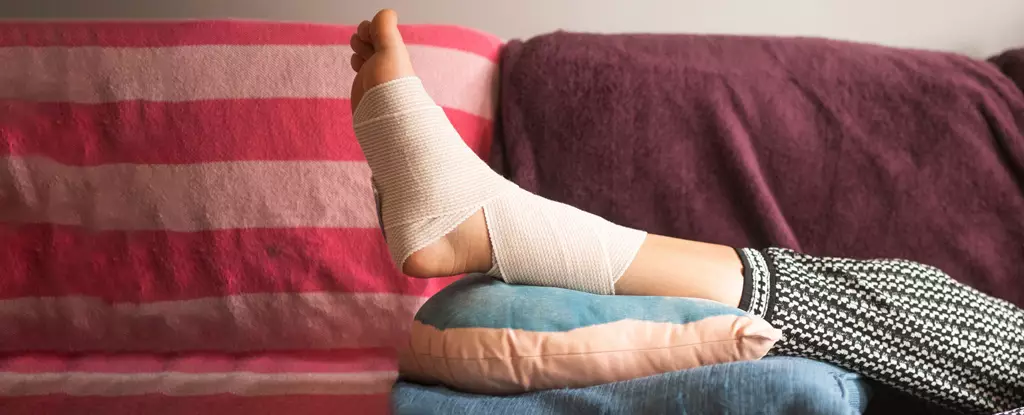When discussing ankle sprains, one might typically envision the physical damage to ligaments and tendons. However, a groundbreaking perspective posits that these physical injuries may also invoke significant changes within the brain. Recent research in movement science uncovers a link between physical injuries and alterations in the brain’s processing and perception of movement. This evolving understanding emphasizes the need to explore the less examined facets of rehabilitation and injury prevention strategies, suggesting that addressing brain functionality may enhance recovery outcomes.
At the heart of this exploration is the concept of plasticity, which refers to the brain’s remarkable capacity to adapt and reorganize in response to new experiences or injuries. Research spearheaded by doctoral students, such as Ashley Marchant, reveals that the brain’s perception of movement and pain may change when adjusting the loads we place on our muscles. Specifically, their findings suggest that when load conditions closely mimic normal gravity, our movement sense is more accurate. Conversely, reduced loads lead to less precise movement perception. This insight compels us to reevaluate traditional approaches to rehabilitation, which have long prioritized physical training over the cognitive aspects of movement control.
Despite athletes appearing physically recovered from an injury, statistical evidence indicates that their risk of reinjury remains significantly elevated—sometimes two to eight times higher—compared to individuals without an injury history. This troubling statistic indicates a gap in sports medicine: recovery protocols have predominantly focused on physical rehabilitation while neglecting the accompanying alterations in sensory processing and brain function. Therefore, a new focus on gait and sensory perception could be crucial for preventing further injuries and understanding the underlying brain changes that accompany physical trauma.
An important revelation from current research is the role of sensory input in movement control. Nerve pathways responsible for sensory input outnumber those for motor output by approximately ten to one. This disparity highlights the significance of sensory information in movement perception. By measuring sensory input quality from key systems—including the vestibular system, visual system, and proprioception in the lower limbs—researchers can glean insights into how effectively the brain processes movement-related information.
The implications of this research extend beyond athletic recovery. For instance, astronauts experience a significant shift in their sensory perception when they leave Earth’s gravitational influence. Their reliance on different movement strategies can lead to decreased activation of muscle groups once they return to environments where gravity is a factor. This adjustment period necessitates a professional approach to understand and counteract the potential for falls or injuries upon relanding.
Similar to astronauts, athletes may also face alterations in brain function stemming from injuries. After sustaining an injury, an athlete might adopt compensatory movement patterns, such as limping. Such adjustments can distort the sensory feedback the brain receives from the affected leg, leading to misperceptions of movement dynamics. This shift could hinder optimal recovery and lend credence to the idea that prior injuries predispose athletes to future complications.
Research is beginning to correlate these sensory perception metrics with athletic performance across diverse sports. For young athletes, enhanced sensory awareness may even serve as an early predictor of their potential talent. Conversely, for older adults, diminished performance on sensory assessments can foretell an increased risk of falls. This correlation suggests a pivotal relationship between physical activity levels, sensory perception, and overall safety in aging populations.
In light of this data, the emergence of precision health offers a promising avenue for enhancing rehabilitation methods not only for athletes but also for diverse populations, such as astronauts and seniors. Precision health leverages advancements in technology, including artificial intelligence, to customize treatment approaches based on individual assessments of movement and sensory capabilities. This tailored strategy stands to revolutionize rehabilitation practices, fostering a more comprehensive understanding of the interconnectedness between physical injuries and cognitive processing.
As we delve deeper into the relationships between brain function, movement control, and injury prevention, it becomes imperative that professionals in sports medicine rethink their approaches to rehabilitation. By incorporating assessments of sensory processing and prioritizing brain health alongside physical healing, the field can pave the way for more effective recovery protocols. In doing so, we not only enhance the performance and safety of athletes but also address the broader implications for individuals at all stages of life. This holistic perspective ensures that movement science evolves to meet the needs of our dynamic world.


Leave a Reply